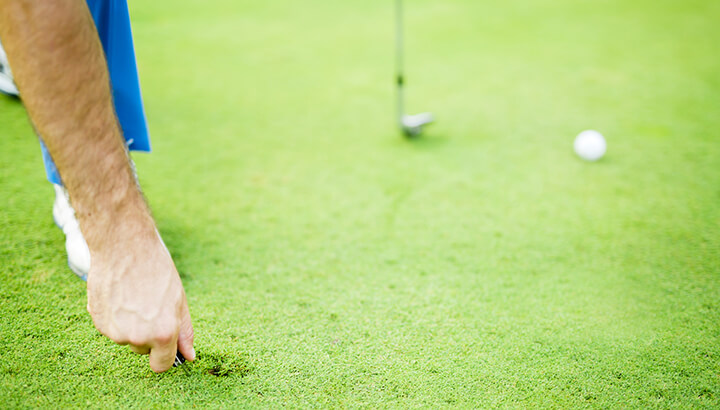Sand or no sand? Hammering, hacking in or stomping? Light dusting or build a dune? It’s horses for courses as different grasses, at different times of the year, will produce different types of divots, which may or may not inform the local maintenance regime.
The first requirement for contemplating divot repair is to understand the expectations and practices for the course you are playing. It’s a sensitive subject, as it affects the condition of the course and potentially your and others’ enjoyment of the round. Here are some things to consider:
Course requirements
Some courses expect, in fact require, you to do nothing at all. They will not issue sand buckets to players. This can come about because members and guests are a little over-enthusiastic about using sand to completely cover the divot — creating a pile that is neither smooth nor stomped down.
These types of repairs are often worse than doing nothing at all, since the over abundance of sand (minus the original turf, which lies somewhere ahead on the ground) stifles all likelihood of the area regenerating. The sand is often spread far wider than the injury and, worst of all, future shots for balls landing in this sand can be more difficult than simply hitting from bare ground.
Many of the “big name” courses have staff that come out each evening or early morning, sweeping the course as a team to fill divots correctly. They use a specially seeded mixture to ensure quick regrowth.
Types of repair
Often courses will not issue sand buckets, rather expecting you to repair divots by using the bottom of your iron and hacking in the adjoining grass. The Australian Golf Course in Sydney, home to The Australian Open in 2014 and 2015, does just that.
Using the bottom of your iron, hammer around the edges of the divot so that the grass is given a fair chance to “catch” and knit with the soil below. This is a good technique but might seem shocking if you haven’t seen it in action — from afar it might resemble a momentary temper tantrum!
Others require you to replace the grass from the divot, with or without sand addition. It’s a technique largely dependent on the type of grass used. The expectation is that players will retrieve their grass and bring it back to the divot. Sometimes sand is also added and a firm foot press is needed to assist with the grass replacement.
Good etiquette
Properly repairing your divot means observing some etiquette around creating and fixing the damage you have created. The rules of the game stipulate that all players should repair their divots on fairways and greens. All too often we see telltale grass clumps lying 15 yards away from the culprit shot. It is quite obvious that the player made no attempt to either retrieve the grass nor even a cursory effort with remediating the wound left on the fairway. Good etiquette dictates that you should return the grass patch to the source and attempt to remediate it to its starting point.
When sand is issued (often stated as compulsory sand buckets to be taken) the expectation is that you’ll not only repair your own fairway divots but also attend to other unfilled ones as well. A recently visited golf course divided the 18 holes into small groups of the alphabet, that is Hole 1 was A-C, Hole 2 D-F, etc. If your surname fell into that group then you were expected to take some ownership of the hole. And this meant taking a full bucket of sand and emptying it before you reached the green by filling divots.
This need not take long if you have the sand container in hand. Quickly splash some sand then use a firm press of the foot or the wheel of your trolley. You will be empty in no time at all. This interesting approach also applied to divots on the green.
When in doubt…
If in doubt, respect the basic expectation for repairing a fairway divot. Retrieve as much of the grass as possible, bring it back to the bare patch, place back into position, dust with sand as supplied and stand on the divot. A visual check should be made. Ask yourself this question, “If my ball were to land on that spot tomorrow, could I play it off this surface with a high degree of confidence?” If the answer is “yes,” then you have probably repaired the divot to a respectable standard.
There really is no excuse for not repairing your fairway divot. It takes 20 seconds tops to complete some type of repair and it makes all the difference for the next player who lands in that spot.
— N. Incoll
